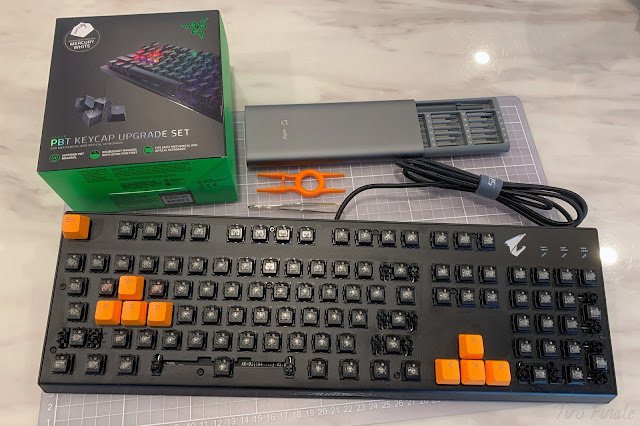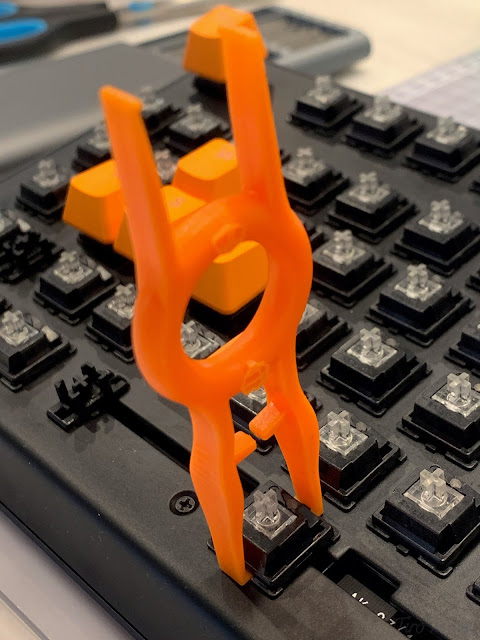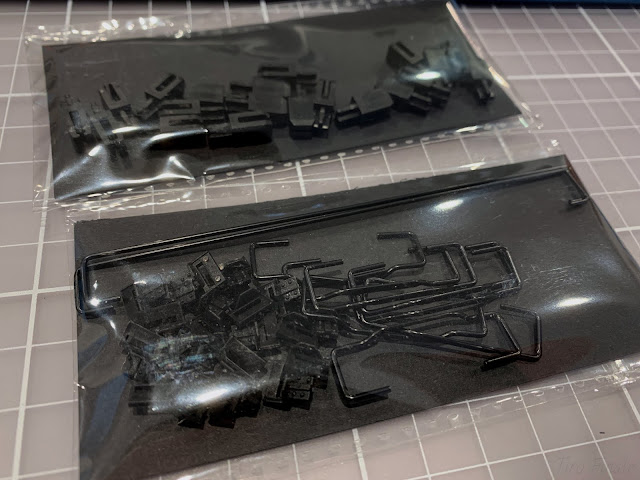Project K9 Part 3: Switch & Keycaps
Hello everyone and welcome back to Tiro Finale for the penultimate chapter of Project K9. In case you have missed the past build logs, here is a little refresher to catch you up to speed. In the first part, we covered a detailed introduction of Gigabyte's flagship mechanical keyboard, the Aorus K9 and all of its unique features including hot-swappable optical switches and water resistance. In the second part, the modding process started in actuality with the chassis being taken apart and filled with foam and the stabilizers lubricated.
Today in the third chapter of the My Modding series featuring the Aorus K9, we will be focusing on the largest portion of input of any keyboard, the switches and the key caps. Starting with the Flaretech optical switches, these are comparable to the Outemu and Gateron optical variants out in the market. The Flaretech optical switches are easily the rarest among the available optical switches in the market and that may come down to cost where these switches cost as much as traditional mechanical switches while those from Gateron/Outemu cost less.
One of the defining features of the Flaretech switch in the K9 is its hot swappable nature meaning it can be easily removed from the PCB and replaced with another similar switch atop it. Several keyboards equipped with Gateron optical switches also allow for this option as the construction of optical switches are inherently more friendly towards hot swapping as they rely on contact points rather than pins.
After a brief discussion with my friend (the eventual owner of this keyboard), we decided to reassign several keys to the clicky variants. With most of the board filled out otherwise with smooth linear switches, the decision was made to populate the space bar, Q, W, E, A, S, D and F keys with the clicky switches.
The entire process was really simple and could be completed in just a matter of minutes. All that needs to be done is to use the included plastic tool to remove the switch from the plate and to push in the replacement switch with your fingers. Since it is plate mounted, the switches can be installed even before it is mounted onto the PCB.
Then, the next step was to simply populate the overlying switches with appropriate key caps. As you can see, I have decided to go with the orange PBT key caps that came included with the Aorus K9. I have said it before and I will say it again, the machining on the plate by Gigabyte really is second to none as there is satisfying click when inserting the switches with a nice snug fit. The fit is also secure without any of the switches coming loose when trying to pull out the key caps, an issue sometimes seen in cheaper hot swap keyboards.
Here is quick comparison of the sound difference between the clicky and linear Flaretech switch. It has a nice sharp click to it and is distinctively quieter than those from Cherry Blues (and its associated Blue clones).
Having used up seven of the nine available clicky switches, I decided to place the eight clicky switch into the Escape button.
Meanwhile, the directional arrow buttons remained standard with the linear switches. These do not see as much as the WASD keys when it comes to gaming so, the decision was made to keep these standard.
Of course, we were still going to use the Orange PBT key caps that came provided with it. Till now, I am impressed by how the bright these orange key caps look.
Joining alongside the orange PBT key caps are another set of double shot PBT keycaps. These are the Razer PBT Keycap Upgrade Set in Mercury White and would certainly be a big upgrade over the standard ABS key caps that the Aorus K9 came with.
The all white Razer PBT keycaps are kept in four plastic blister packs and are arranged in a sequential order going left to right and top to bottom. This was a rather interesting arrangement that I have never seen done by other key caps manufacturers before. Aside from the standard ANSI key layout, they also come included with ISO layouts keys, additional modifier keys (Shift, Ctrl, Alt) and a plastic key cap remover.
Because Razer keyboards do not use standard stabilizers, the set also comes included with stabilizers for both their Black Widow and Huntsman mechanical keyboards.
The Aorus K9 uses standard stabilizers from the get go. As such, we will not have to use these. That being said, I do have an old Razer Black Widow lying around which could use some much needed upgrades and the mechanical stabilizers may just be the thing that I am looking for.
The decision to purchase the Razer PBT key caps was not an easy one and was only made after a lot of deliberation. The decision was made to go for a two tone Panda (black and white) color scheme to match my friend's existing setup. As such, I had to source an all-white double shot PBT shine through key caps with good availability, pricing and quality. The Razer Mercury Whites just happened to be the key cap set which ticked all of those boxes and had an added bonus of matching well with the Razer Deathadder mouse that he used.
Compared side by side with the Aorus K9's original ABS key cap, you would be able to notice the slight difference in profile with the Razer one being a slightly larger key cap. Moreover, the bump placement on the F key also differed between the two but, would unlikely cause any real world issues in touch typing.
Turn the keys around and you would immediately notice the biggest difference between the two key caps with the PBT one having significantly thicker side walls compared to the ABS ones. In fact, the Razer ones were slightly thicker than my Tai Hao ones. Although, the Tai Hao(s) still felt subjectively denser.
Throw the included orange PBT keycap into the mix and you will see that the Aorus one strikes a happy medium between the two.
It has significantly thicker walls than the ABS one but, it still thinner than the Razer one. Texture wise the Razer's also have a rougher texture which comes down to individual preference. I am not a fan of how the orange PBT key caps not having circular stems but, I doubt it would cause any actual issue in real world usage.
And all of that difference in side wall thickness actually makes significant real world changes. Don't believe me? Just check out the sound comparison video of the three above.
Comparison done, it was time to put everything together. Things were really starting to come together until a little conundrum occurred with the Function keys. As the Razer PBT key caps were primarily aimed at being used on Razer keyboards, the function shortcuts do not actually match the ones assinged on the K9.
I tried including the original black ABS key caps atop the function row thinking it would help add a nice touch of color to the two tone design.
Nevertheless, I found the all white with orange accents to still look much better and, ultimately, that was the final setup that I went with. I am just going to have to remind my friend to always consult to the manual rather than the actual keys themselves when wanting to access some shortcuts on his keyboard. Hopefully it becomes second nature in no time.
With the new white key caps installed, I put the remaining black key caps back into the original plastic blisters that the white Razer key caps came with and they fit perfectly. Another good reason why you should never throw away key cap packaging.
The nine extra switches and key caps were remounted and arranged neatly in the box that it came with.
I made sure to boot up the keyboard for a full testing making sure the lights and all the keys worked. Good news, they passed with flying colors.
Finally with all of the work done, here is how the keyboard sounds with all of its upgrades. It sure has a very unique sound signature with its mix of linear and clicky switches. But most of all, I am happy to hear the high pitched tone removed almost completely replaced with a much denser and solid tone.
It cannot be seen here but, I am also really happy with the how the stabilizers turned out with really smooth key strokes on the space bar, enter and shift keys. Admiring both the color scheme and lighting effects, I figured this project would not be complete without a proper name. So say hello to the final product of Project K9, Sleipnir, named after the KG-6 Sleipnir Kataphrakt that is seen in the series Aldnoah Zero.
Mods done and keyboard tested, it was time to pack everything up and ready it for shipping. It will be a long journey to my friend's place and I am hoping it will make it in time for his birthday. A lot rides on the outcome of this project as I sincerely hope he is satisfied with the final product. While the building and modifications are all but complete, there still remains one final chapter for Project K9 as we will be doing a full proper photo shoot for this keyboard before sending it off. In the meantime, if you have any questions about the build of the keyboard in general, do not hesitate to let me know in the comments section below. Until the next time, thank you so much for reading and have yourself a wonderful day ahead!
Today in the third chapter of the My Modding series featuring the Aorus K9, we will be focusing on the largest portion of input of any keyboard, the switches and the key caps. Starting with the Flaretech optical switches, these are comparable to the Outemu and Gateron optical variants out in the market. The Flaretech optical switches are easily the rarest among the available optical switches in the market and that may come down to cost where these switches cost as much as traditional mechanical switches while those from Gateron/Outemu cost less.
One of the defining features of the Flaretech switch in the K9 is its hot swappable nature meaning it can be easily removed from the PCB and replaced with another similar switch atop it. Several keyboards equipped with Gateron optical switches also allow for this option as the construction of optical switches are inherently more friendly towards hot swapping as they rely on contact points rather than pins.
After a brief discussion with my friend (the eventual owner of this keyboard), we decided to reassign several keys to the clicky variants. With most of the board filled out otherwise with smooth linear switches, the decision was made to populate the space bar, Q, W, E, A, S, D and F keys with the clicky switches.
The entire process was really simple and could be completed in just a matter of minutes. All that needs to be done is to use the included plastic tool to remove the switch from the plate and to push in the replacement switch with your fingers. Since it is plate mounted, the switches can be installed even before it is mounted onto the PCB.
Then, the next step was to simply populate the overlying switches with appropriate key caps. As you can see, I have decided to go with the orange PBT key caps that came included with the Aorus K9. I have said it before and I will say it again, the machining on the plate by Gigabyte really is second to none as there is satisfying click when inserting the switches with a nice snug fit. The fit is also secure without any of the switches coming loose when trying to pull out the key caps, an issue sometimes seen in cheaper hot swap keyboards.
Having used up seven of the nine available clicky switches, I decided to place the eight clicky switch into the Escape button.
Meanwhile, the directional arrow buttons remained standard with the linear switches. These do not see as much as the WASD keys when it comes to gaming so, the decision was made to keep these standard.
Of course, we were still going to use the Orange PBT key caps that came provided with it. Till now, I am impressed by how the bright these orange key caps look.
Joining alongside the orange PBT key caps are another set of double shot PBT keycaps. These are the Razer PBT Keycap Upgrade Set in Mercury White and would certainly be a big upgrade over the standard ABS key caps that the Aorus K9 came with.
The all white Razer PBT keycaps are kept in four plastic blister packs and are arranged in a sequential order going left to right and top to bottom. This was a rather interesting arrangement that I have never seen done by other key caps manufacturers before. Aside from the standard ANSI key layout, they also come included with ISO layouts keys, additional modifier keys (Shift, Ctrl, Alt) and a plastic key cap remover.
Because Razer keyboards do not use standard stabilizers, the set also comes included with stabilizers for both their Black Widow and Huntsman mechanical keyboards.
The Aorus K9 uses standard stabilizers from the get go. As such, we will not have to use these. That being said, I do have an old Razer Black Widow lying around which could use some much needed upgrades and the mechanical stabilizers may just be the thing that I am looking for.
The decision to purchase the Razer PBT key caps was not an easy one and was only made after a lot of deliberation. The decision was made to go for a two tone Panda (black and white) color scheme to match my friend's existing setup. As such, I had to source an all-white double shot PBT shine through key caps with good availability, pricing and quality. The Razer Mercury Whites just happened to be the key cap set which ticked all of those boxes and had an added bonus of matching well with the Razer Deathadder mouse that he used.
Compared side by side with the Aorus K9's original ABS key cap, you would be able to notice the slight difference in profile with the Razer one being a slightly larger key cap. Moreover, the bump placement on the F key also differed between the two but, would unlikely cause any real world issues in touch typing.
Turn the keys around and you would immediately notice the biggest difference between the two key caps with the PBT one having significantly thicker side walls compared to the ABS ones. In fact, the Razer ones were slightly thicker than my Tai Hao ones. Although, the Tai Hao(s) still felt subjectively denser.
Throw the included orange PBT keycap into the mix and you will see that the Aorus one strikes a happy medium between the two.
It has significantly thicker walls than the ABS one but, it still thinner than the Razer one. Texture wise the Razer's also have a rougher texture which comes down to individual preference. I am not a fan of how the orange PBT key caps not having circular stems but, I doubt it would cause any actual issue in real world usage.
Comparison done, it was time to put everything together. Things were really starting to come together until a little conundrum occurred with the Function keys. As the Razer PBT key caps were primarily aimed at being used on Razer keyboards, the function shortcuts do not actually match the ones assinged on the K9.
I tried including the original black ABS key caps atop the function row thinking it would help add a nice touch of color to the two tone design.
Nevertheless, I found the all white with orange accents to still look much better and, ultimately, that was the final setup that I went with. I am just going to have to remind my friend to always consult to the manual rather than the actual keys themselves when wanting to access some shortcuts on his keyboard. Hopefully it becomes second nature in no time.
With the new white key caps installed, I put the remaining black key caps back into the original plastic blisters that the white Razer key caps came with and they fit perfectly. Another good reason why you should never throw away key cap packaging.
The nine extra switches and key caps were remounted and arranged neatly in the box that it came with.
I made sure to boot up the keyboard for a full testing making sure the lights and all the keys worked. Good news, they passed with flying colors.
It cannot be seen here but, I am also really happy with the how the stabilizers turned out with really smooth key strokes on the space bar, enter and shift keys. Admiring both the color scheme and lighting effects, I figured this project would not be complete without a proper name. So say hello to the final product of Project K9, Sleipnir, named after the KG-6 Sleipnir Kataphrakt that is seen in the series Aldnoah Zero.
Mods done and keyboard tested, it was time to pack everything up and ready it for shipping. It will be a long journey to my friend's place and I am hoping it will make it in time for his birthday. A lot rides on the outcome of this project as I sincerely hope he is satisfied with the final product. While the building and modifications are all but complete, there still remains one final chapter for Project K9 as we will be doing a full proper photo shoot for this keyboard before sending it off. In the meantime, if you have any questions about the build of the keyboard in general, do not hesitate to let me know in the comments section below. Until the next time, thank you so much for reading and have yourself a wonderful day ahead!




























Nice work. I have the k9 with blue switches and it is extremely loud. Will the mods you showcased here make mine any quieter?
ReplyDeleteWith the mods I implemented, it would be unlikely to quieten the clicky switches on the K9 by much due to the inherent nature of the Blue switch. If you would like to silence your K9, my best recommendation would be to either swap the switches out for the linear variants or use O-ring silencers.
Delete